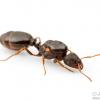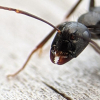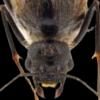I have a colony of these with several hundred workers (possible close to 1,000).
Started with a single queen in a test tube. When I thought that there were about 20 workers I moved them into a Tar Heel Ants "inception chamber" with its 3 inch ant nest. I was wrong, there were actually well over 100. In less than a year the colony outgrew it, with workers hanging around outside the ant nest since there was no room inside. I then moved them into a round 3 inch diameter plastic container filled with sand with a small hole so they could dig their nest to suit their desires. I drilled small hole into the top to be able to insert the tip of a syringe to hydrate it. I have found that the higher the humidity the better.
Fast forward this colony is almost 2 years old. Because of their tiny size they are difficult to contain. Currently they are living in two 4x4x2 Tar Heel Ants ytong ant nests on a platform (plastic dish) placed on the bottom half of a thread spool holder (found at fabric store) filled with water (think moat). The best thing about the thread spool holder is that it has 40 spindles holding the platform above the water line so its very stable.
What I have noticed from this colony is that rarely does more than possibly 1% of the workers ever leave the nest.
I also want to caution you: I keep all my colonies on a shelf, pulling each off the shelf, one at a time, to maintenance it. Rarely had I seem the B. Pats climb the sides of their housing (ant nest inside a foraging area with a tightly sealed lid). And, generally, they would tuck themselves in every night around 9pm. About a month ago... at some point during the night a group of them ( a couple of hundred) left their home and ventured over to and found a way into the ant nest of my Dorymyrmex Bureni colony (about 200 workers). Even though the D. Bureni are easily 8-10 times larger, the B. Patagonicus slaughtered all of the D. Bureni! (I am still grieving). Although these tiny ants might seem quite shy around people and will "run" home when the foraging area is being serviced, do not be fooled --- they are amazingly vicious when given the chance.
The mature colony can grow to impressive size in miniature, but they because of their size they are difficult to contain. So far the only thing I have found that works is the moat.



















